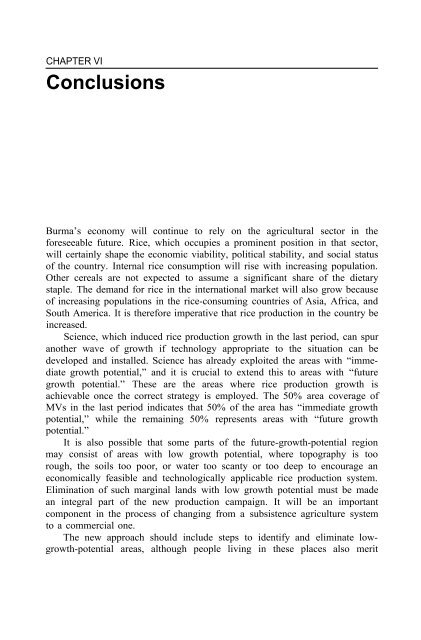A century of rice improvement in Burma - IRRI books - International ...
A century of rice improvement in Burma - IRRI books - International ...
A century of rice improvement in Burma - IRRI books - International ...
- No tags were found...
Create successful ePaper yourself
Turn your PDF publications into a flip-book with our unique Google optimized e-Paper software.
CHAPTER VIConclusions<strong>Burma</strong>’s economy will cont<strong>in</strong>ue to rely on the agricultural sector <strong>in</strong> theforeseeable future. Rice, which occupies a prom<strong>in</strong>ent position <strong>in</strong> that sector,will certa<strong>in</strong>ly shape the economic viability, political stability, and social status<strong>of</strong> the country. Internal <strong>rice</strong> consumption will rise with <strong>in</strong>creas<strong>in</strong>g population.Other cereals are not expected to assume a significant share <strong>of</strong> the dietarystaple. The demand for <strong>rice</strong> <strong>in</strong> the <strong>in</strong>ternational market will also grow because<strong>of</strong> <strong>in</strong>creas<strong>in</strong>g populations <strong>in</strong> the <strong>rice</strong>-consum<strong>in</strong>g countries <strong>of</strong> Asia, Africa, andSouth America. It is therefore imperative that <strong>rice</strong> production <strong>in</strong> the country be<strong>in</strong>creased.Science, which <strong>in</strong>duced <strong>rice</strong> production growth <strong>in</strong> the last period, can spuranother wave <strong>of</strong> growth if technology appropriate to the situation can bedeveloped and <strong>in</strong>stalled. Science has already exploited the areas with “immediategrowth potential,” and it is crucial to extend this to areas with “futuregrowth potential.” These are the areas where <strong>rice</strong> production growth isachievable once the correct strategy is employed. The 50% area coverage <strong>of</strong>MVs <strong>in</strong> the last period <strong>in</strong>dicates that 50% <strong>of</strong> the area has “immediate growthpotential,” while the rema<strong>in</strong><strong>in</strong>g 50% represents areas with “future growthpotential.”It is also possible that some parts <strong>of</strong> the future-growth-potential regionmay consist <strong>of</strong> areas with low growth potential, where topography is toorough, the soils too poor, or water too scanty or too deep to encourage aneconomically feasible and technologically applicable <strong>rice</strong> production system.Elim<strong>in</strong>ation <strong>of</strong> such marg<strong>in</strong>al lands with low growth potential must be madean <strong>in</strong>tegral part <strong>of</strong> the new production campaign. It will be an importantcomponent <strong>in</strong> the process <strong>of</strong> chang<strong>in</strong>g from a subsistence agriculture systemto a commercial one.The new approach should <strong>in</strong>clude steps to identify and elim<strong>in</strong>ate lowgrowth-potentialareas, although people liv<strong>in</strong>g <strong>in</strong> these places also merit

















